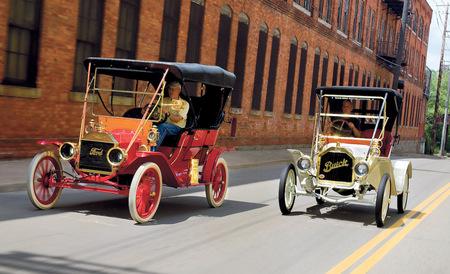In the autumn of 1908, the flag of the United States of America had 46 stars, the population was less than 89 million, Teddy Roosevelt was about to vacate the White House and William Howard Taft would soon move in, and this country’s young automotive industry stood at the threshold of profound change.
Though still primitive, automobiles had advanced from infancy to the edge of adolescence. As an illustration of how far cars had come in American life, T.R. was the first President to ride in a car, and Taft became the first to own one.
There were still some technological uncertainties—steam? electric? internal combustion?—but most carmakers had settled on gasoline engines as the way to deliver performance, acceptable range, and reliability. Emphasis on the latter. Early manufacturers quickly saw the publicity benefit of durability, and despite the primordial state of U.S. highways—rural roads were mostly just collections of ruts and mud—pioneering motorists were tackling driving adventures that almost defy comprehension in today’s age of interstate freeways, nav systems, cruise controls, and air conditioning.
In the summer of 1897, Alexander Winton and his shop boss, William Hatcher, drove a two-cylinder Winton from the company’s Cleveland plant to New York City in 11 days. In 1903, Dr. Horatio Jackson and Sewall Crocker added to the company’s lore with a Winton touring car, driving it from San Francisco to New York. The trip took 63 days, many of them spent in train depots, awaiting parts. Still, Jackson proved that coast-to-coast auto travel was possible. And in February 1908, six teams set out to prove more than that as they embarked on the New York to Paris race. Sponsored by the New York Times, the idea was that the competitors would drive west to Seattle, north through Alaska, and then west across the frozen waters of the Bering Strait. Yeah, right. The teams traversed the Pacific by ship instead, and three of them—led by American George Schuster in a Thomas Flyer—actually made it to Paris: 22,000 miles, 169 days.
By 1908, there were somewhere between 200,000 and 400,000 motor vehicles registered in the U.S., and there were some 250 to 500 companies busily making more of them (statistics vary wildly), with Buick and Ford leading the pack. So if the automobile was still something of a novelty, priced beyond reach of most, it was clearly not going away.
Billy and Henry
Against this backdrop, two men were poised to change the automotive landscape. Two very different men.
Using Buick as his financial lever, William C. Durant established General Motors on September 16, 1908, filing incorporation documents in New Jersey. Under Durant’s leadership, Buick output had zoomed from 4641 cars in 1907 to 8820 in 1908, propelled by the new Model 10 (from $900), which accounted for about half of the company’s production that year.
Lacking a clear idea of where the industry’s future lay—big expensive cars? small affordable ones? cars featuring new technology?—Durant decided that GM should be all things to all customers. That philosophy endured well beyond his life span, but Durant’s approach to implementing his vision quickly became chaotic. A merger overture to Henry Ford was turned down, but Durant added Oldsmobile to the GM roster that November, Oakland (Pontiac predecessor) in April 1909, and Cadillac that July, as well as two companies that would eventually become GMC Truck.
All those acquisitions panned out. But 1909 saw 17 others that ranged from so-so to what was he thinking? By 1910, GM was in financial trouble, the directors were restless, the bankers more so, and that November, Durant relinquished control of the company as a condition of a financial rescue.
Henry Ford’s vision was different: Build one car; make it simple, durable, efficient, and above all, inexpensive—a car, as he said, “for the great multitude,” something to be achieved by economies of scale. The Model N of 1906 came close to that goal with a base price—for a two-seat roadster—of $500, though four-seat editions were more expensive.
At the time, Ford also offered a more luxurious car, the six-cylinder Model K (from $2500), as well as the earlier Model F (from $1100). Ford added Models R (from $750) and S (from $700) in 1907, but they were fancier editions of the popular N.
Meanwhile, the Model T was taking shape in a sequestered third-floor corner of Ford’s factory at the corner of Piquette Avenue and Beaubien Street in Detroit. Now a National Historic Landmark, the Piquette plant was some 10 times the size of Ford’s earlier Mack Avenue building.
Ford started operations in the Piquette plant in late 1904, and by 1906, when the T began its gestation, the once ample space was cramped. By the time the T made its official debut, October 8, work was well advanced on the vast factory in nearby Highland Park, where the T would write the big chapters in its amazing history. Still, the car was born at the Piquette plant, and some 10,000 Model Ts rolled out of its doors before all operations moved to Highland Park.
View Photos
View Photos


Leave a Reply